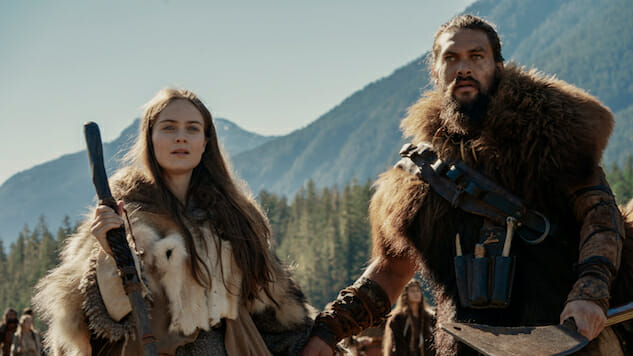See: How the Apple TV+ Dystopian Drama Finds a New Way to Look at Blindness
Photo Courtesy of Apple
There is far too much about the most dystopian of Apple TV+’s new line-up to unpack in just a few minutes. See, set in a far-flung future where centuries ago humanity literally lost its ability to see, is full with small touches and big swings that add up to an extremely dense narrative. But, during a recent junket hosted by Apple, members of the cast and director Francis Lawrence made an effort to hint at the layers of complexity in store.
At the center of the story, created by Steven Knight (Peaky Blinders), are Kofun (Archie Madekwe) and Haniwa (Nesta Cooper), the two adopted children of Baba Voss (Jason Momoa). Voss is a warrior who knows it’s essential to protect them because they were born with the ability to see, making them a threat to forces like the evil Queen Kane (Sylvia Hoeks) and her loyal witch hunters, led by Tamacti Jun (Christian Camargo). While the focus of the premise is on the question of (literal) vision, those involved were excited to explore how the show’s large ensemble could represent a wide range of stories.
“Typically in TV and movies, and things like that,” Lawrence said, “blind people are often portrayed as victims, somebody who needs saving or somebody who needs fixing. And so the idea of having the opportunity to tell stories where these characters can just be sort of fully formed human beings—they can be great heroes, there can be evil queens, you know, like we can have the full spectrum of people. Blindness is an aspect of that, but it’s not the thing that defines them.”
As Cooper added, “It’s really fun to see people who are blind as different people—not just a token diverse person. Everyone has their own personality.”
And it offers up a unique twist on old cliches of “in the land of the blind,” because as Cooper put it, “the concept of blindness doesn’t really exist until we come in,” because this is a world where blindness is the norm.
The world-building of the series is dense, but the cast was an active part in developing it. “They did build everything, but they built it with us,” Camargo said. “It wasn’t like we had to fit into a formula, because being part of a first season meant we were very involved. I mean, as actors, you don’t often get an opportunity to dive into a new world and brand new creation like this.”
Hoeks agreed, adding that “really collaborating from the beginning meant that we understood the language so much, because you have to represent a world that has been blind for 600 years, where that is the norm. And I think collaborating and creating this world together made us feel very at home in what we were doing.”
While the production teams worked to literally build the show’s look and feel, the actors spent several weeks collaborating with blindness consultant Joe Strechay, movement choreographer Paradox Pollack, and others to create the details which populate the show.
-

-

-

-

-

-

-

-

-

-

-

-

-

-

-

-

-

-

-

-

-

-

-

-

-

-

-

-

-

-

-

-

-

-

-

-

-

-

-

-








































